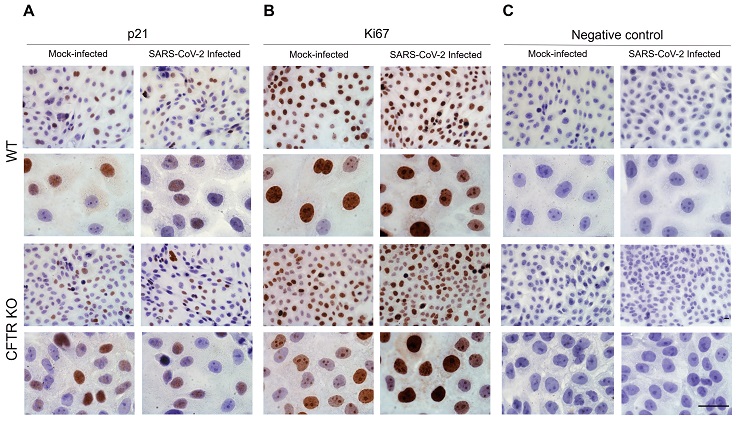Nikhil Prasad Fact checked by:Thailand Medical News Team Jun 05, 2024 10 months, 1 week, 1 day, 10 hours, 50 minutes ago
COVID-19 News: The COVID-19 pandemic, driven by the SARS-CoV-2 virus, has affected millions globally, but its effects on cellular mechanisms are still being unraveled. Recent studies have highlighted how SARS-CoV-2 induces cellular senescence, a state where cells stop dividing and undergo distinctive biochemical changes, in vivo. Cellular senescence is often associated with aging and chronic diseases, including cystic fibrosis (CF). This
COVID-19 News report delves into the fascinating interplay between SARS-CoV-2 infection and CF, particularly focusing on the role of the CFTR protein, commonly defective in CF patients.
 CFTR's Role in Reversing Senescence in SARS-CoV-2 Infected Cells
CFTR's Role in Reversing Senescence in SARS-CoV-2 Infected Cells
Immunohistochemical analysis of cellular senescence hallmarks in mock- and SARS-CoV-2-infected WT and CFTR KO 16HBE14o-cells. (A) p21 immunoreactivity in mock- and SARS-CoV-2-infected WT and CFTR KO 16HBE14o-cells after 48 h of culture. (B) Ki67 immunoreactivity in mock- and SARS-CoV-2-infected WT and CFTR KO 16HBE14o-cells after 72 h of culture. (C) Negative control in mock- and SARS-CoV-2-infected WT and CFTR KO cells at 72 h of culture. Bars: 15 µm.
Cellular Senescence: A Double-Edged Sword
Senescence is not merely a marker of aging but also a complex cellular response that can act as a defense mechanism against diseases. It is characterized by the activation of cyclin kinase inhibitors like p16INK4a and p21Cip1, resistance to apoptosis, and the release of various inflammatory factors known as the senescence-associated secretory phenotype (SASP). However, senescence can also create a pro-inflammatory environment, which can be detrimental in the context of viral infections.
SARS-CoV-2 and Cellular Senescence
Several studies have shown that SARS-CoV-2 can induce senescence in different cell types, exacerbating inflammation through the SASP. This virus-induced senescence (VIS) may play a role in the hyperinflammatory responses observed in severe COVID-19 cases. Interestingly, clinical trials on senolytics, drugs that target senescent cells, have shown promising results in mitigating these effects.
Cystic Fibrosis and CFTR
Cystic fibrosis (CF) is a genetic disorder that affects the lungs and other organs, caused by mutations in the CFTR gene. The CFTR protein is crucial for maintaining the balance of salts and fluids in various tissues. In CF patients, the defective CFTR protein leads to thick, sticky mucus that can block airways and promote infections. This study explores the intriguing observation that CFTR-defective cells respond differently to SARS-CoV-2 infection compared to cells with functional CFTR.
Investigating CFTR's Role
Researchers from the University of Verona and “G. d’Annunzio” University of Chieti-Pescara conducted an in-depth study to investigate the senescence markers in SARS-CoV-2 infected cells with and without f
unctional CFTR. They used two types of bronchial epithelial cells: wild-type (WT) with functional CFTR and CFTR knockout (KO) cells.
Pre-Infection Observations
Before infection, CFTR KO cells exhibited higher levels of the senescence marker p21 and lower levels of the proliferation marker Ki67 compared to WT cells. This suggested a more pronounced senescent state in the absence of CFTR. Additionally, lipid accumulation, identified as lipolysosomes and residual bodies, was more prominent in CFTR KO cells.
Post-Infection Findings
After infecting the cells with SARS-CoV-2, the researchers observed a reversal of senescence markers in CFTR KO cells. These cells showed lower p21 and higher Ki67 expression post-infection, indicating a reduction in senescence and an increase in proliferation. Conversely, WT cells exhibited increased senescence markers after SARS-CoV-2 infection. Interestingly, CFTR KO cells also had reduced viral gene expression compared to WT cells.
Detailed Cellular Analysis
Using various analytical techniques, including immunohistochemistry and real-time PCR, the researchers provided detailed insights into cellular changes. They found that SARS-CoV-2 infection led to lipid accumulation in both WT and CFTR KO cells, but the patterns varied significantly. In WT cells, lipid droplets and autophagosomes containing viral replication structures were prominent, facilitating the virus's lifecycle. In contrast, CFTR KO cells showed impaired viral replication and fewer lipid droplets, suggesting that the absence of CFTR disrupts the virus's ability to exploit the cellular machinery.
Implications for CF Patients
The study's findings have significant implications for CF patients, who appear to have a reduced clinical impact from COVID-19. The lower susceptibility to severe SARS-CoV-2 infection in CF patients might be linked to the altered senescence pathways and reduced viral replication in CFTR-defective cells. This could explain the milder COVID-19 symptoms observed in CF patients compared to the general population.
The Role of Senotherapeutics
The study also touches on the potential of senotherapeutics in treating viral infections. By targeting senescent cells, these drugs could help reduce viral load and inflammation in infected individuals. The CFTR-defective phenotype seems to mimic the effects of senolytic drugs, offering a natural advantage against SARS-CoV-2.
Conclusion: Unraveling the Molecular Interplay
This research provides novel insights into the molecular mechanisms underlying the different responses to SARS-CoV-2 infection in CF and non-CF cells. The CFTR protein plays a crucial role in modulating senescence and viral replication, highlighting a complex interplay that could inform future therapeutic strategies. Further studies are needed to fully understand these mechanisms and their implications for treating COVID-19 and other viral infections.
The study findings were published in the peer reviewed International Journal of Molecular Sciences.
https://www.mdpi.com/1422-0067/25/11/6185
For the latest
COVID-19 News, keep on logging to Thailand Medical News.
Read Also:
https://www.thailandmedical.news/news/covid-19-news-weill-cornell-study-finds-that-sars-cov-2-infects-and-triggers-senescence-of-dopamine-neurons-metformin-helps
https://www.thailandmedical.news/news/breaking-covid-19-news-study-finds-that-omicron-variants-have-a-unique-ability-to-induce-cellular-senescence
https://www.thailandmedical.news/news/warning-sars-cov-2-infections-are-accelerating-t-cell-immunosenescence-and-increasing-cardiovascular-disease-risks-in-cmv-seropositive-individuals
